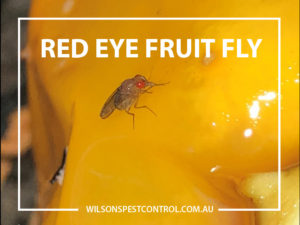Fruit Flies (Fermentation Flies)
What may be a small insect can actually become a big problem in your kitchen, whether it is at home or if you own a restaurant or industrial kitchen space. For instance, did you know that fruit flies can get inside a fridge and wreak havoc? I found this out the hard way. Ugh. So much cleaning!!! But there are solutions for this tiny, annoying fly.
These small flies are known by several names: fermentation flies (fermi flies for short), vinegar flies (they are attracted to vinegar primarily because it gives off acetic acid, the same volatile chemical given off by rotting fruits), and most commonly fruit fly. The life cycle of fruit flies includes four distinct stages: Eggs, Larvae, pupae and adult – each of these stages can play a part in the control of fruit flies.
Their life cycle in detail:
Adults live about 30 days in suitable (humid) conditions. Females will lay eggs throughout most of their life. Eggs hatch in about 24 hours after laying, but in warm habitats they can hatch earlier. The larval stage is spent in the food the female has selected. Larvae can complete development in 3-5 days again depending on temperature. When fully grown they crawl out of their food nursery (technical term=substate) and form the puparium. The adult emerges from this puparium in several days. The important features of the life cycle are the habits of the individual stages. Females select places to lay eggs based on where they were feeding in their larval stage; they will be attracted to these sites. So, you see how an infestation and a suitable substrate can be infested over a long period. Females and males will often hover or be present in areas that are humid and have favourable odour, decaying vegetation; they may lay eggs in these places. Larvae of both the red-eye and dark-eye feed immersed in the wet and usually decaying substrate. They are small and you cannot see them very well. The puparia are small and seed-like, but you may be able to find them on the edges of places that are not or have been infested. You can always distinguish fruit fly puparia by the two “horns” that stick out the front.
The adult can easily travel on vegetables when they are brought into a commercial establishment or house. There may be natural reservoirs of breeding populations outside the restaurant in dumpsters or garbage somewhere close to an entry door. When trying to solve fruit fly problem in a restaurant treating the inside is not enough; you need to treat the outside as well.
What is interesting is that the adults take in little food, mostly liquids from the substrate they will lay eggs on. Males will land on wet surfaces to drink. It is the larval stage that does all the feeding to relieve the adults from this task; all they have to do is mate and lay eggs. Larvae feed on a variety of things: the red-eye will be on vegetables in a variety of stages, mostly preferring an advanced state of decay, the dark-eye will be in dark, decaying, organic matter – such as the scum around the floor drains or in sink traps, a well rotten potato, plant and animal material.
The fruit flies don’t travel far from their breeding site, but they will move to a humid location even if they are not laying eggs there, which explains why they hang out around sinks. Flies breed in poor sanitation of the bar sinks, beer scum, food debris. They hover over and in alcohol bottles because they are attracted to this odour. When vegetables decay they emit some alcohols that are attractive to the flies. It is important to wipe down the bottles and bar areas thoroughly after each service.
So how do you know which fly may be an unwelcomed guest in your kitchen? Identification is important because it can help to direct the sanitation and control program. Most often people can see the red-eye fruit flies because they hover; the dark-eye flies don’t hover, but may be seen on walls and the ceilings.
The red-eye fruit fly is typically a seasonal pest because of the food the larvae infest and the dependence of the adults on humid conditions. Warm humid months will favour the red-eye. The adults will usually be close to the infested material. Whereas the dark-eye fruit fly are usually year-round pests since they don’t depend on rotting vegetables as a food substrate. They get established in grime and decaying material in restaurants – material that seems to always be there and they remain a pest.
Crucial to solving the problem is a thorough look inside and outside reservoirs. Think where attractive odours may be generating, like decaying material, fermenting material, sugar around drink machines. The most effective control of fruit flies is a sanitation or cleaning program, but most places need someone to instruct the employees where to clean.
Places to Clean for Prevention and Tips:
- The drink machine, if there are any leaks or mouldy pans attract flies to the site. This is a favoured place for fermentation flies in fast food places. Also check the ice machine where it is draining.
- Vegetable storage bins are crucial not so much as what is in the bins but what has fallen out of the bin and is now lodges under a table or refrigerator and is well rotted. There may be no odour because it is too far under the appliance but the flies can smell the rotting fruit or vegetables
- Sinks of all sorts are attractive because of the humidity and food odours. This will create the perfect breeding site for the flies.
- It is important to undertake a cleaning program to clean under tables, chairs and sinks, grease traps, internal and external reservoirs where organic debris collects at the back or around the drains. By using a flashlight these area should be inspected.
- Floor drains are a site for several flies. Phorid flies may be there along with moth flies, dark-eyed fruit flies can also be present.
- Baseboards especially tile floor edges are often overlooked as a breeding site for dark-eye fruit flies. Material gets pushed into the cracks and crevices by mopping the wet floor; the decay provides a suitable breeding site for the flies and they are not seen easily.
- To control the fruit fly it is crucial to identify the species involved, the probable breeding sites, review the sanitation routine. There is generally little need for insecticides (where would you apply them?). It may be necessary to get a quick knockdown of adult flies when there is a severe infestation; you could arrange to spray the area when the property is not in use at night or early mornings.
- Drains are often a source of the problem. Inspect them regularly and have them cleaned. This include drains that are dry and don’t get regular water running through them. These can be an odour source and attract flies because the water trap has dried. Pour some water in these drains to re-establish the water trap in the elbow.
- Microbial cleaners can be a big help. They are mixtures of bacteria and feed on grease and decaying matter, breaking down so debris is washed away. These microbials reduce the food value of the substrate so that fruit flies don’t do well but the microbial don’t kill fly larvae. Foaming drains and floor drains with a microbial is beneficial.
Contact Us if you are looking for Pest Control Services in Blacktown & Hills District.



Fruit Fly




